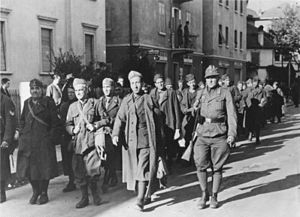This article needs additional citations for verification. (August 2018) |
This article includes a list of references, related reading, or external links, but its sources remain unclear because it lacks inline citations. (October 2021) |
| Operation Achse | |||||||
|---|---|---|---|---|---|---|---|
| Part of the Italian campaign of World War II | |||||||
 Disarmed Italian soldiers marching to captivity in Bozen. | |||||||
| |||||||
| Belligerents | |||||||
|
|
| ||||||
| Commanders and leaders | |||||||
|
|
| ||||||
| Strength | |||||||
| 60 divisions (26 in Italy, 31 in the Balkans, 3 in France) | 40 divisions (17 in Italy, 19 in the Balkans, 4 in France) | ||||||
| Casualties and losses | |||||||
|
20,000–30,000 killed 1,006,370 disarmed Captured by Germans: 977 armored vehicles 16,631 vehicles 17,058 artillery pieces and mortars Many warships Captured by Romanians: 496 prisoners[1] 5 midget submarines[2] | Unknown | ||||||
Operation Achse (German: Fall Achse, lit. 'Case Axis'), originally called Operation Alaric (Unternehmen Alarich), was the codename for the German operation to forcibly disarm the Italian armed forces after Italy's armistice with the Allies on 3 September 1943.
Several German divisions had entered Italy after the fall of Benito Mussolini in July 1943, while Italy was officially still an ally of Germany, despite the protests of the new Italian government under Pietro Badoglio. The armistice was made public on 8 September. German forces moved rapidly to take over the Italian zones of occupation in the Balkans and southern France, and to disarm Italian forces in Italy.
Some Italian troops, with no orders from superiors, and hampered by desertions, resisted the Germans. On the Greek island of Cephalonia, 1,315 Italian soldiers were killed in action against the Germans and over 5,100 Italian soldiers from the 33rd Infantry Division "Acqui" were summarily executed by the German Army after running out of ammunition and surrendering. In Rome, with the royal family and the government having fled, a disorganized defense by Italian troops of the capital was unable to withstand a German attack. Some individual soldiers and sometimes whole units, like the 24th Infantry Division "Pinerolo" in Thessaly, went over to the local resistance. Only in Sardinia, Corsica, Calabria and the southern part of Apulia were Italian troops able to offer successful resistance and hold off the Germans until relieved by the arrival of the Allies.